Growing marjoram is rewarding, and their care is simple. In this post I’ll show you everything you need to know in order to have the best success.
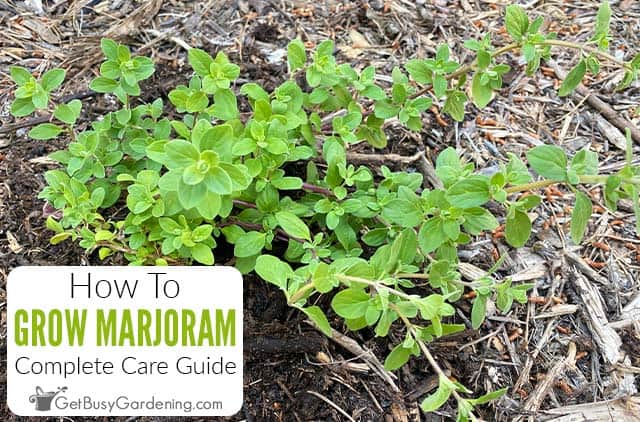
Learn how to grow fragrant marjoram to make a wonderful addition to your garden.
It’s a low maintenance plant that’s great for beginners who want to enjoy home grown herbs.
This guide will help anyone start growing marjoram by sharing all the essential care steps it takes to keep it thriving.
Discover what soil, water, sun, and fertilizer needs it has, how to prune, and so much more, all in one place.
Marjoram Plant Care Overview
| Scientific name: | Origanum majorana |
| Classification: | Herb |
| Common names: | Marjoram |
| Hardiness: | Zones 7+ |
| Temperature: | 60-70°F |
| Flowers: | Pink or white, blooms spring through early fall |
| Light: | Full sun to partial shade |
| Water: | Allow soil to dry between waterings, do not overwater |
| Humidity: | Average |
| Fertilizer: | General purpose plant food in spring and summer |
| Soil: | Fast-draining, fertile soil |
| Common pests: | Aphids, cutworms, or spider mites |
Information About Marjoram
Marjoram (Origanum majorana), is a member of the Lamiaceae family that also includes mint, lavender, and thyme.
This easy-growing, drought tolerant herb has a pronounced flavor that’s favored in cooking. It’s native to the Mediterranean and Southwest Asia, but is now found all over the world.
The purple and white flowers are attractive to pollinators, and the fuzzy green leaves are fragrant, and can grow up to 2’ tall.

Different Types Of Marjoram Plants
There is only one true type of marjoram. It’s typically sweet with green leaves, but you may find variegated varieties with yellow marbling as well.
Many new gardeners often confuse pot and wild marjoram as additional varieties. But, despite the common names, those are actually types of oregano.
While they both belong to the same family and have similarities in appearance, they are in fact different herbs.
Hardiness
Many people grow marjoram as an annual, but it’s actually a tender perennial that can survive winters in zones 7+.
It will die outside in climates that experience colder temperatures, but can be overwintered indoors.
How Does Marjoram Grow?
The small green leaves of marjoram grow on square brown stems that form upright bushes, which can reach up to 2’ tall.
The stems sprout from shallow rhizomes and roots under the ground, and can spread in warm enough climates.
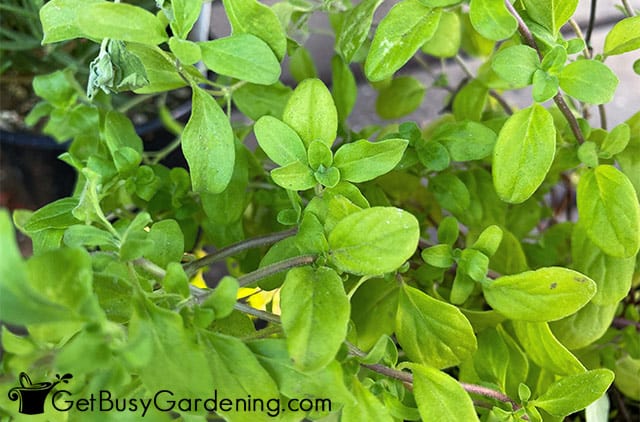
How To Grow Marjoram
Before we talk about marjoram plant care, it’s important to know when and where to grow it. Choosing the right time and location can make a big difference to how well it thrives.
Where To Grow Marjoram
Marjoram can be grown in the garden, and is often used as a decorative edging.
It also does well indoors or in containers, which is a popular choice for gardeners in colder climates who want to overwinter it.
When To Plant Marjoram
For best results, wait to plant marjoram until the last chance of frost has passed in the spring.
The ideal soil temperature is 70°F, which you can easily check with a probe thermometer.
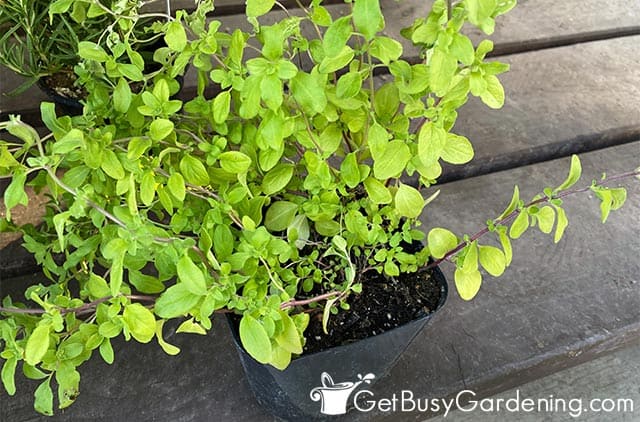
Marjoram Plant Care & Growing Instructions
Now that you understand when and where to plant it, let’s talk about growing marjoram. Creating its ideal environment will help keep its care low-maintenance.
Sunlight
Marjoram prefers a full sun location with at least 6 hours of direct exposure every day.
Very hot climates can dry out the shallow roots. Provide partial shade during the hottest part of the afternoon to prevent that, but avoid excessive shade, which can cause legginess.
Water
Though it’s drought tolerant, the flavor is better when marjoram receives consistent moisture.
Keep the soil evenly moist until established, then allow it to dry 1-2” down between drinks.
Be careful about overdoing it however. It won’t tolerate wet feet for long, and overwatering is a common cause of death. Use a moisture meter to help you get it just right.
Temperature
The ideal temperature range for growing marjoram is between 60-70°F. It tolerates heat well, though it will bolt and be more susceptible to stress at very high temps.
It can do well down to 50°F, but will suffer if exposed for long periods of time. Anything below freezing will trigger dormancy, and extreme cold will kill it.
Fertilizer
There is rarely a need to fertilize marjoram if it’s growing in decent soil. Too much can cause rapid growth that results in legginess and reduced flavor.
If yours has been in the same spot or container for a few years however, the occasional feeding can rejuvenate it.
Add a balanced liquid fertilizer like compost tea or fish emulsion, or add granules once in the spring and summer.
Soil
Marjoram isn’t particular about its soil, and can grow well in even poor quality mixes as long as they don’t retain moisture.
Though it can tolerate pH from 4.5-8.5, the ideal soil is a sandy, fertile, well-draining, alkaline mixture with a range between 6.5-7.0. A probe meter can help you check what you have.
Amend very heavy or clay-based soils with compost or worm castings before planting to improve the drainage, and add some garden lime to neutralize high acidity.
Pruning
Consistent pruning throughout the spring and summer will encourage bushier growth and larger yields.
To maintain leaf flavor and production, use precision snips to cut it back to the ground when you see flower buds begin to form.
You can also do this after the flowers are spent to stimulate new growth for a second harvest in the fall.
Pest Control
Though the strong flavor and fragrance keeps many pests away, marjoram can sometimes be attacked by thrips, aphids, cutworms, or spider mites.
Treat insects with neem oil, or wash the leaves with an insecticidal soap.
You can make your own spray by mixing 1 teaspoon of mild liquid soap with 1 liter of water.
Disease Control
One reason why growing marjoram is so hands-off is that it’s largely free of diseases. But sometimes it can be affected by root rot, rust, and mildew.
The best way to prevent these issues is by maintaining good watering practices, and increasing airflow through consistent pruning.
Avoid overhead irrigation to prevent splashing soil and moisture sitting on the leaves.
Tips For Harvesting Marjoram
Harvesting marjoram is simple. Just cut the sprigs with a sharp, clean pair of scissors or precision snips.
You can begin as soon as it’s 5” tall, but avoid taking more than a third of the overall plant at a time.
The best flavor occurs just before the flowers open. Remove them before they bloom to increase your harvest time.
Marjoram Propagation Tips
Marjoram is very easy to propagate. It reseeds willingly if allowed to flower, or can be multiplied by cutting or division.
Dividing mature plants is a great way to rejuvenate them with new growth, and is best tackled in early spring.
For the best success, take cuttings in late spring or early summer before the flowers begin to form.
Troubleshooting Common Problems
Marjoram is a low maintenance plant that’s usually not very difficult to grow. However, if you run into any of these common issues, use my tips below to get them back into good health.
Plant Is Bolting / Going To Seed
Flowering is a natural part of the yearly life cycle for marjoram, induced by the summer heat.
The blooms are attractive for pollinators, and useful if you’d like to allow it to reseed for new plants the following year.
However it does detract from the flavor of the leaves. Trim away any flowers before they open to keep the plant focused on leaf production.
Leaves Turning Brown
The most common causes for browning leaves are root rot, severe drought, and fungus.
Never water to the point of puddling the soil, but also try to avoid prolonged periods of drought, especially in hot weather. A moisture meter can be useful in getting it just right.
If you see brown spots or other signs of fungus, begin treating it right away. A natural fungicide and trimming away affected leaves can prevent it from spreading.
Marjoram Not Growing
There are a few reasons marjoram may stop growing. The most common causes are cold temperatures, lack of light, or drought.
When temperatures drop to 50°F, the plant will be very slow or stop growing all together.
If it’s not receiving at least 6 hours of sun a day, or allowed to go for very long periods without water, you may see leggy, sparse, or stalled growth as well.
Yellow Leaves
Yellowing is most often caused by overwatering, excess fertilizer, nutrient deficiencies, pests, or the plant is root-bound.
If left in very wet soil for too long, rot can begin to cause yellowing. Allow it to dry out several inches between drinks to avoid that.
It may be a lack of nitrogen, but if you’ve been applying fertilizer, it could be burning the leaves. It’s best to test the soil to see what’s lacking or out of balance.
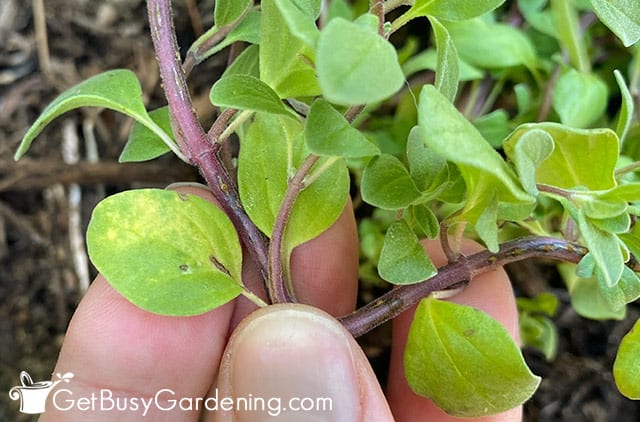
FAQs About Growing Marjoram
Here I’ve answered some of the most commonly asked questions about marjoram plant care. If yours isn’t on the list, please add it to the comments section below.
Is marjoram easy to grow?
Marjoram is very easy to grow if you provide it with enough sunlight and occasional deep waterings.
How long does it take to grow marjoram?
Marjoram takes about 70-90 days to grow to full maturity, depending on the quality of care and the environment.
Where does marjoram grow best?
Marjoram grows best in sandy, well-draining soil with at least 6 hours of sunlight.
Does marjoram come back every year?
Marjoram will come back every year in zones 7+, or if it is overwintered indoors. It may also reseed itself in colder climates.
Does marjoram prefer sun or shade?
Marjoram prefers full sun, except in very hot weather where it will do best with some afternoon shade. Excess shade will cause legginess and sparse leaves.
Now that you see how simple it is to care for, growing marjoram can be a fun and enjoyable project for your home garden. The tips provided here will help you get it established and keep it thriving.
If you’d like to learn how to get as much homegrown food as possible, then my Vertical Vegetables book is perfect! It will teach you all you need to know, has tons of gorgeous inspirational photos, and 23 DIY projects you can build for your own garden. Order your copy today!
Learn more about my Vertical Vegetables book here.
More About Herb Gardening
Share your tips for growing marjoram in the comments section below.


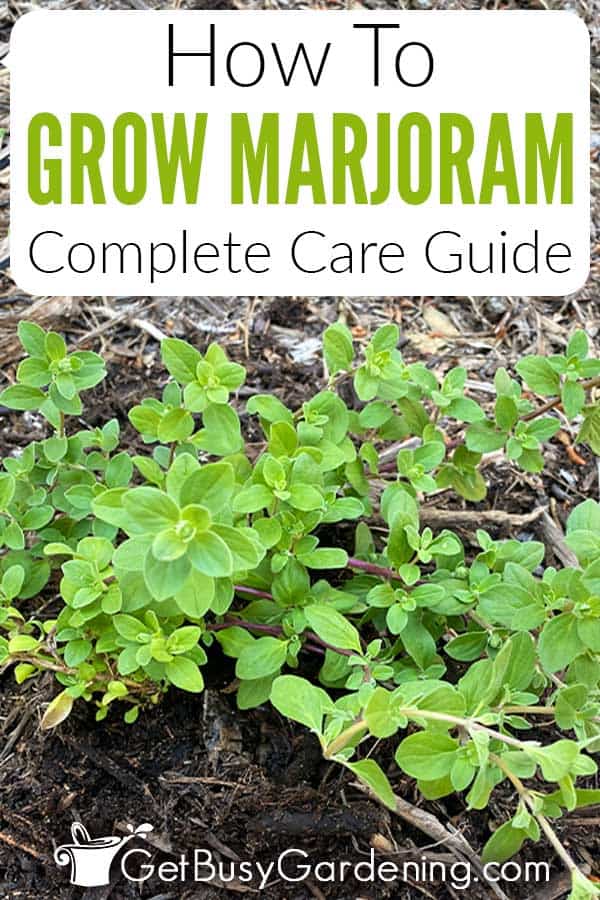

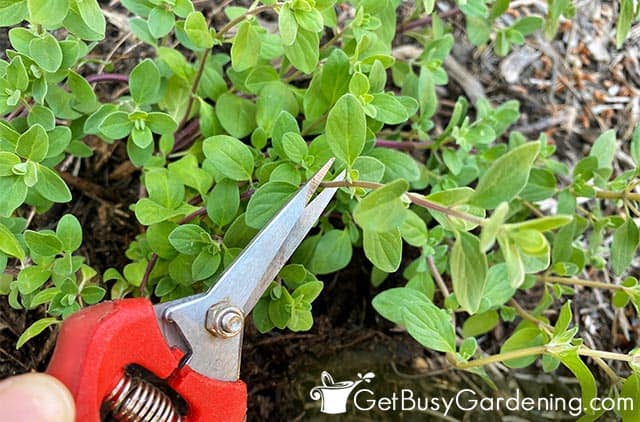


Leave a Reply